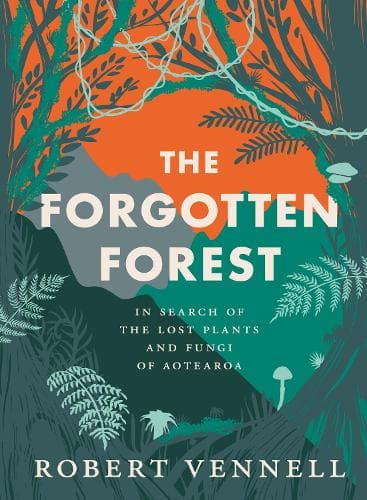Review: The Forgotten Forest
Reviewed by Alex Eagles
The latest book from bestselling natural history author Robert Vennell is a fantasy foray through the forests of Aotearoa, full of fascinating facts about fungi, lichens, liverworts, mosses and slithery slime moulds.
Vennell's excellent debut book, The Meaning of Trees, shortlisted for the Ockham Book Awards, is packed with historical and modern drawings, photos and information, so too is Secrets of the Sea, which followed in 2022 and was also shortlisted for an Ockham. As a big fan of both of these, I was eager to devour The Forgotten Forest: In search of the lost plants and fungi of Aotearoa.
It is distinctly different from Vennell's earlier works. Most of the illustrations are confined to the front and back of the book, and without page references in the text, I found locating the relevant image often tricky. In addition to being smaller in stature, the layout is unusual, with inexplicably wide page margins.
In contrast to Vennell's earlier books_, The Forgotten Forest_ is written in first person narrative but the easy-to-read, slightly whimsical style would be perfect for someone wanting a fictional story imbued with information about natural New Zealand.
The Forgotten Forest takes an imaginary journey from our alpine areas to the wetlands, regaling the reader with mythical and medicinal material about the miniature world that is all around us but rarely noticed. Vennell mixes biological information from the botanical branches of bryology (the study of mosses, liverworts, and hornworts) and mycology with folklore and rongoā Māori (traditional healing) with the latest scientific research.
A few fungi facts include that they flourish beneath our feet, forming underground webs up to half a kilometre square; some glow in the dark; others look like red zombie hands emerging from the ground; while the beautiful blue mushroom, werewere kōkako, that appears on our $50 note, is being explored as a natural blue food dye for lollies, etc.
Hanging from trees and covering rocks, lichens are a partnership between fungi, algae and sometimes bacteria, cohabitating as one. These organisms are also fantastic chemical factories producing natural antibiotics, fungicides, insecticides, herbicides, sunscreen, antifreeze, but wait, there's more, and a chemical to break down bioplastics!!
Who knew Aotearoa was a hotspot for liverworts, with more than 700 species growing near our waterways, including the two largest in the world? Māori used kōpuru liverwort as a perfume; but it’s not wise to dab just any liverwort behind your ears as the scent of some can be putrid.
Aotearoa is home to the tallest moss in the world, the delightfully named pāhau kākāpo or moustache of the kākāpo. Many mosses have medicinal properties, which have seen them used as nappies for newborns and bandages for soldiers. In addition to their antiseptic abilities, sphagnum moss is used to absorb toxic chemicals such as oil spills.
Thank goodness slime moulds are not your usual kitchen variety because they can move, grow to 5 metres and weigh 20 kilograms. Slime moulds have been used to treat pathogens such as thrush and even certain cancers. They may also have an environmental pollution application as they are able to absorb high levels of heavy metals. With names like dog vomit, disco ball and chocolate-tube slime, you have to love these weird and wonderful organisms, which engineers use to plan roading networks since the mould finds the most efficient route through topographical models from point A to point B.
With its beautifully designed cover, The Forgotten Forest is an invitation to investigate the incredible inhabitants of the often unexplored understory of New Zealand's ngahere (forest), as even those of us passionate about spending time in the natural environment usually neglect to examine the miniature forests flourishing at our feet or on the bark of a tree just beyond the tip of the nose.
Reviewed by Alex Eagles
